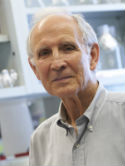Cleavage of membrane-anchored growth factors involves distinct protease activities regulated through common mechanisms Journal Article
| Authors: | Pandiella, A.; Bosenberg, M. W.; Huang, E. J.; Besmer, P.; Massague, J. |
| Article Title: | Cleavage of membrane-anchored growth factors involves distinct protease activities regulated through common mechanisms |
| Abstract: | The membrane-anchored forms of transforming growth factor-α (TGF-α) and stem cell growth factors (Kit ligands) KL-1 and KL-2 are converted to soluble growth factor forms by a regulated proteolytic cleavage process. Each of these proteins is cleaved at a distinct site, however their cleavage is activated via a common set of intracellular signaling mechanisms. By using a panel of protease inhibitors, we show here that at least two cell-associated serine protease activities with distinct specificities participate in membrane growth factor cleavage. Two serine protease inhibitors of broad specificity, diisopropylfluorophosphate and 3,4-dichloroisocoumarin, prevent the cleavage of proTGF-α and KL-1 but not that of KL-2. Of the agents tested, N-tosyl-L-phenylalanine chloromethyl ketone and various haloenol lactone derivatives are the most potent inhibitors of cleavage of all three membrane growth factors. It is concluded that cleavage of membrane-anchored growth factors involves a proteolytic system with multiple serine protease activities regulated through common mechanisms. |
| Keywords: | nonhuman; comparative study; animal cell; animal; stem cell factor; protease inhibitors; protein degradation; cell line; transfection; stem cell; enzyme regulation; protein processing; amino acid sequence; molecular sequence data; protein processing, post-translational; sequence homology, amino acid; serine proteinase; kinetics; serine proteinase inhibitor; membrane protein; cell membrane; rats; growth factor; transforming growth factor alpha; lactone derivative; tetradecanoylphorbol acetate; endopeptidases; cho cell; cho cells; protein precursors; proteinase inhibition; protein precursor; tosylphenylalanyl chloromethyl ketone; priority journal; article; support, non-u.s. gov't; support, u.s. gov't, p.h.s.; hamsters; hematopoietic cell growth factors; 3,4 dichloroisocoumarin; dyflos; isoflurophate |
| Journal Title: | Journal of Biological Chemistry |
| Volume: | 267 |
| Issue: | 33 |
| ISSN: | 0021-9258 |
| Publisher: | American Society for Biochemistry and Molecular Biology |
| Date Published: | 1992-11-25 |
| Start Page: | 24028 |
| End Page: | 24033 |
| Language: | English |
| PUBMED: | 1385433 |
| PROVIDER: | scopus |
| DOI/URL: | |
| Notes: | Article -- Source: Scopus |
Citation Impact
Related MSK Work





